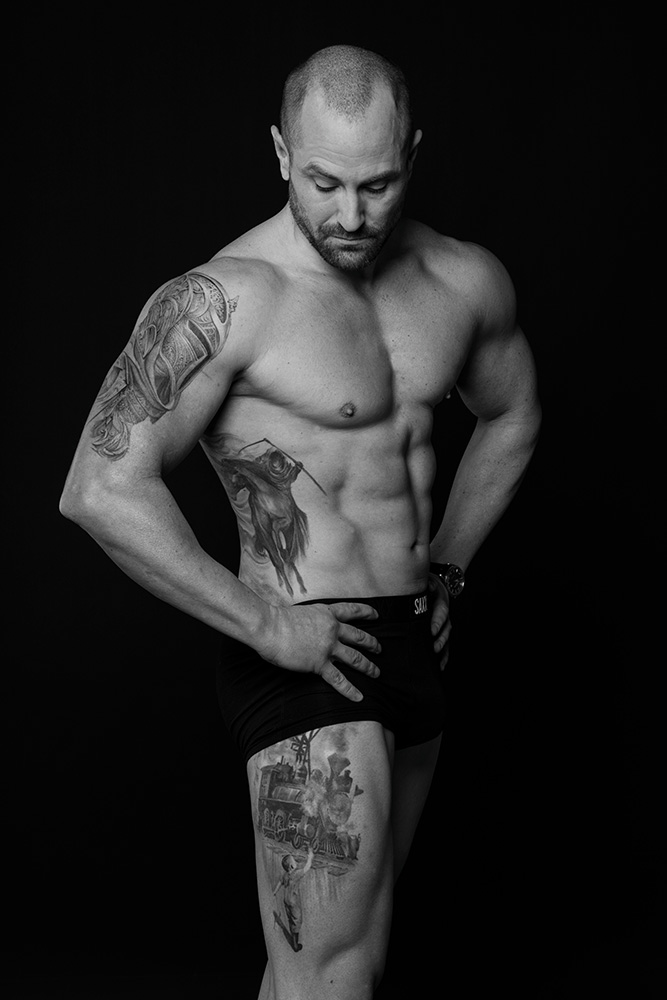
The 2023 Inked OG – Geoff Ratzlaff
Geoff Ratzlaff, a devoted architectural technologist at Aritzia, relocated with his wife, Adriana, and son, Leo, from Vancouver, B.C., to Golden, a serene town in the Rockies. Drawn by both family proximity and a longing for mountainous landscapes and a disconnect from the noise, he is now surrounded by nature finding constant inspiration for his architectural endeavors. This creative spirit extends beyond blueprints, delving into the world of tattoo art. We take a deep dive into the stories behind the captivating tattoos that serve as both an homage to his roots and a reflection of his personal journey.
“Influenced by my three older brothers, whom I’ve always admired, I developed a fascination for tattoos at a young age. Witnessing their tattoos, I was captivated by the striking coolness and personal interests etched within each design, sparking my own exploration into body art,” he said. Drawn to dark realism designs that skillfully evoke raw emotions, Ratzlaff appreciates the intricate portrayal of shadows and depth within this style. For him, dark realism becomes a powerful medium to express the complexities of human experience.
At 15, Ratzlaff got a Celtic tribal on his upper back shoulder blade. It wasn’t until 2018, after two decades of contemplation, that he decided to embark on a more profound tattoo project. “My favorite aspect of my tattoo is the tale it narrates, spanning the pilgrimage of my family from the hardships of the Russian Revolution to the present day. Each inked detail encapsulates our evolving legacy, commemorating the trials, triumphs, and enduring spirit that have shaped our collective history over the decades.”
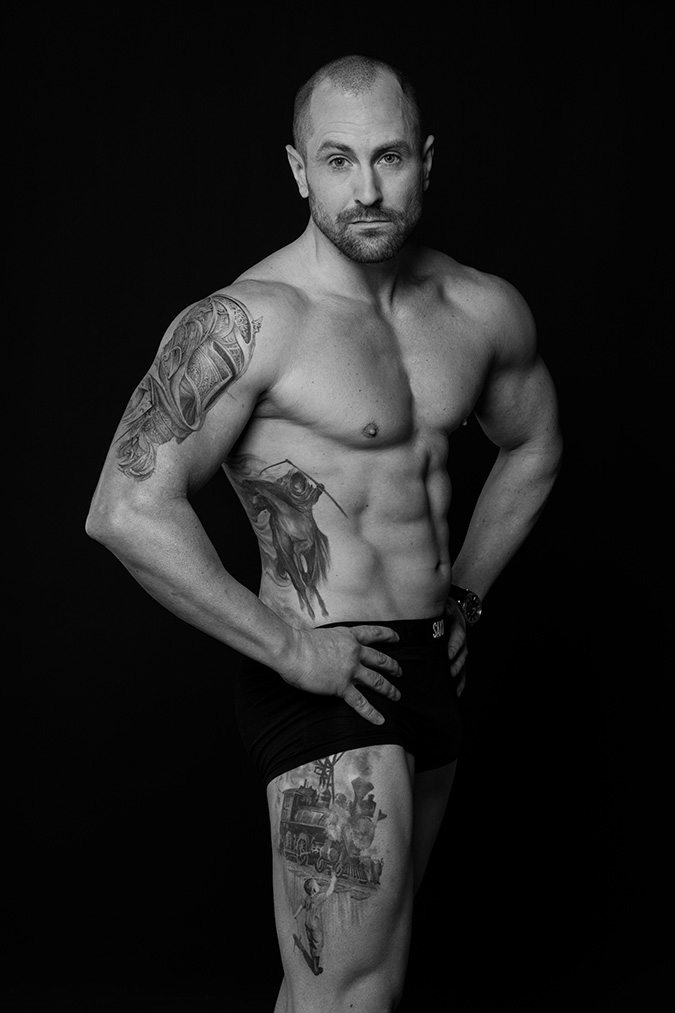
The Four Horsemen
The centerpiece of Ratzlaff’s back piece is an epic story capturing the trials faced by his grandparents as they sought to escape the tumultuous era. The Four Horsemen — death, war, pestilence, and famine — are intricately etched onto his back, symbolizing the obstacles endured by his family. The hauntingly beautiful portrayal of these horsemen encapsulates the challenges they faced during their escape. “They were a part of a big farming colony. And when the revolution happened in Russia, the government basically said everything is the government’s now. So, everything was taken from them, including their farm. They had to get out of there. So, what my tattoo represents are all the things they had to go through before escaping Russia, so they might actually have been the four horsemen — which are, basically, the main things they had to go through to get out of the country.”
The Train through the Red Gate
Continuing the saga, Ratzlaff’s back features a tattoo of a train crossing the Red Gate. This marks the point of freedom, the threshold between oppression and escape. The Red Gate, situated on the Russian/Latvian border, became a symbolic gateway to liberation. The train on Ratzlaff’s leg represents his grandparents’ migration towards freedom, an odyssey that ultimately brought them to Canada.
The Spasskaya Tower at the Kremlin
Adding further historical context, Ratzlaff’s continuous tattoo includes a striking image of the Spasskaya clock tower at the Kremlin. The tower clock is frozen at 5 o’clock, representing the time his grandparents would rise to farm in Russia. This meticulous attention to detail showcases the dedication to capturing every nuance of their journey, emphasizing the sacrifices made during a pivotal chapter in history.
A family united
The culmination of Ratzlaff’s tattoo narrative is a heartwarming image that bridges generations. A picture of his son, Leo, symbolizes the continuation of the family legacy. Leo welcomes his ancestors to freedom and Canada, creating a poignant link between past and present. This blend of historical symbolism and personal connection makes Ratzlaff’s tattoo collection a truly unique and emotionally charged visual chronicle.
A Coat of Arms
His newest addition, which he will continue in an upcoming session, honors his recently departed grandfather, John Ratzlaff, with a coat of arms tattoo on his right arm, paying homage to his patriarchal legacy, incorporating symbols that hold deep significance for the entire family.
Ratzlaff credits his tattoo artist, Mark Roy, with making the meaningful stories come to life. Roy’s expertise in dark realism perfectly complements Ratzlaff’s vision. He’d also like to thank his family and friends for their support during the Inked Originals competition, and he has some advice for tattoo artists and enthusiasts: “Keep posting all your stuff. It’s inspiring to see everybody’s work. I follow a lot of tattooers on Instagram, and so every time you create or get a cool tattoo and post it, it’s inspiring and very much appreciated.”
Mroytattooart.com | @mroytattooart
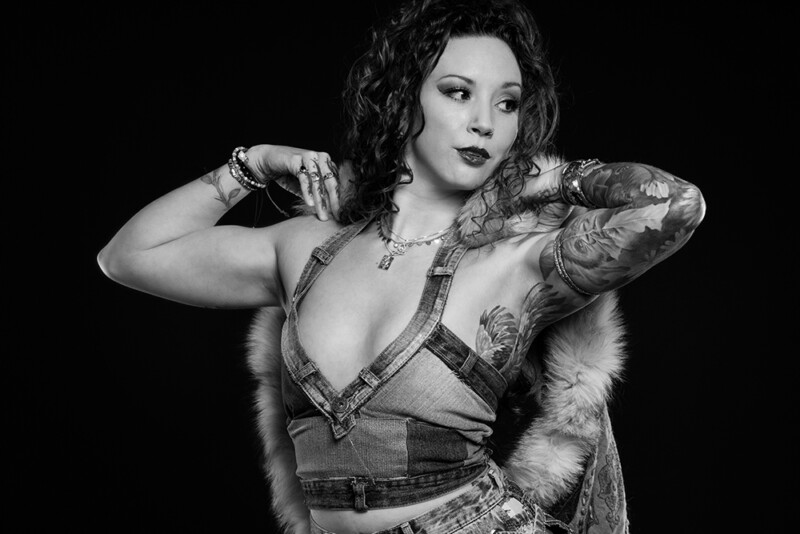
Micki Rayne
A free-spirited goddess on the rise, Micki Rayne reveals her life story through etchings of astrological truths, animalistic evolutions, and ancestral tributes. Though mostly grounded, living in the ‘here and now,’ Rayne’s mind is often in the depths of the constellations, viewing life through a kaleidoscope lens, her world swirling in a colorful duality of light and dark. Rayne started getting tattoos in 2013, counting each one as an individual. But with the help of her beloved tattoo artist, Lindsey Pergentile, at An Tattoo Inc. in Calgary, Alberta, she has moved into a state of flow—where each new piece works in unison with the others, creating one beautiful masterpiece. Each image symbolizes resilience and transformation from the first horse on her upper arm to multiple scorpions, a rose, monkey, wolf, fox, doe, mouse, rabbit, flowers, lion, eagle, rooster, poetry, mantras, and a self-portrait. As she prepares for her next tattoo, the world awaits this Scorpio’s next chapter. @micki.013
Insta: @micki.013
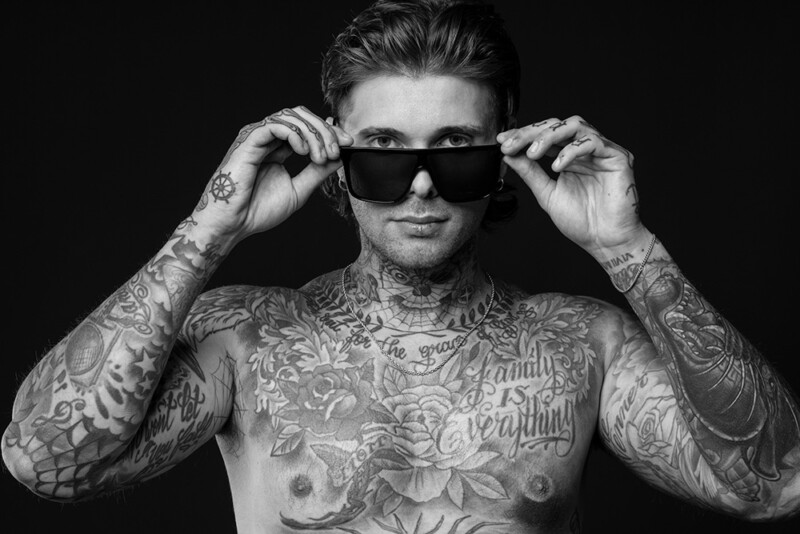
Alec Lerman
Skynard would be a huge fan of Alec Lerman. He’s a ‘simple kind of man’ — authentic, easy to be around, and content with life. Lerman, a 29-year-old Neptune, NJ, resident, is a loyal client of @zackbrysontattoo. His first tattoo was a tribute to his late grandfather, a staple of his family. Since then, Lerman’s collection has grown to include a variety of designs, from family tributes to images of animals, mandalas, portraits, roses, and skulls. Lerman resonates with the simplicity of American traditional tattoos and admires the tebori style. Recently, his focus has shifted towards home life, cherishing moments with his mother, father, daughter, and dogs. He is a huge NY Giants fan and appreciates good food. Lerman offers a refreshing perspective, asserting that not every tattoo needs profound meaning. “You can get pieces just because you think they look cool.” His advice to fellow ink enthusiasts is to invest in quality work, emphasizing that good tattoos aren’t cheap.
X: @_aleclerman | Insta: @aleclerman
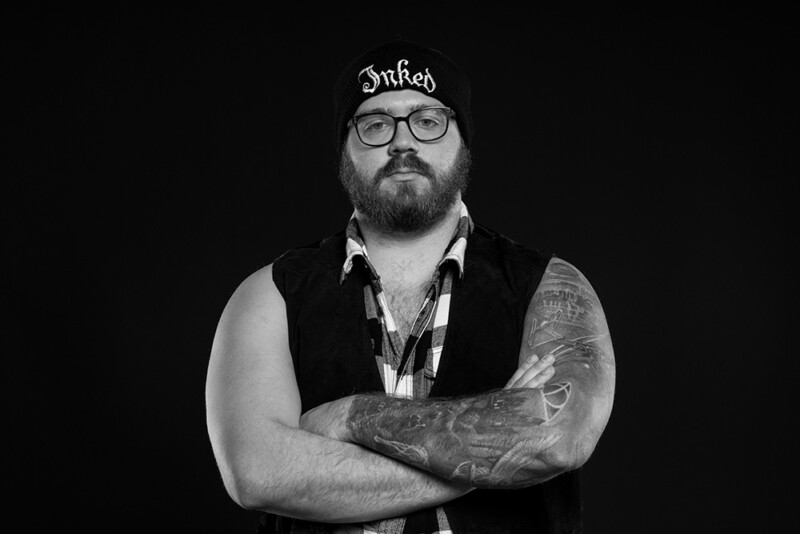
Torry Tucker
Torry Tucker, a 29-year-old Brazilian Jiujitsu coach at Tupelo Jiujitsu Academy in Tupelo, MS, is a fantasy devotee with some sweet mystical ink. He began his tattoo journey with a piece representing the obstacles of life with epilepsy. Tucker then turned to the cosmos, with art displaying the Milky Way in the form of a penguin. His favorite is a colossal sleeve that’s a fantasy lover’s dream. “It starts as the scene from Harry Potter and the Sorcerer’s Stone where the kids first see Hogwarts as they cross over the Black Lake. As the elevation rises up my arm, it transitions into a Star Wars battle for the fate of the galaxy,” he said. “When I first pitched the idea, I thought it would be asking for way too much but I had a vision, and Jacob Jones at Aim High Tattoos took that vision and turned it into some beautiful art.”


















